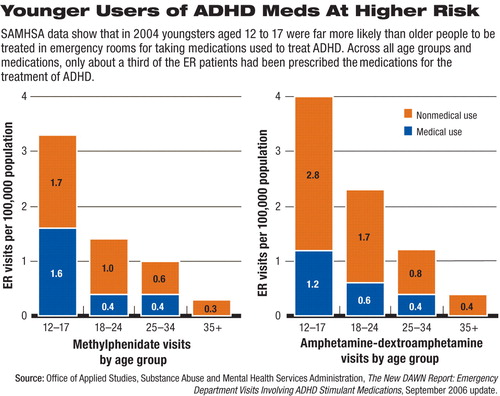Emergency Rooms See More Teens Who Have Abused ADHD Meds
An analysis released last month indicates that young adults aged 18 to 25 appear to have a higher rate of nonmedical use of stimulant medications than those aged 12 to 17, but the younger group may be at greater risk for adverse effects, particularly from nonmedical use.
The report, from the Substance Abuse and Mental Health Services Administration's (samhsa) Drug Abuse Warning Network (DAWN), shows that during 2004 nearly 8,000 visits to an emergency room (ER) involved methylphenidate or amphetamine-dextroamphetamine, the two drugs most commonly prescribed to treat attention-deficit/hyperactivity disorder (ADHD). The rates of ER visits resulting from use of either of these drugs by patients aged 12 to 17 were higher in 2004 than the rates for patients aged 18 or older. In addition, the data suggest that polydrug use—one or more drugs being used in addition to ADHD medication— was common in ER visits involving the misuse of ADHD medication.
“These findings suggest an alarming level of nonmedical use that could have life-threatening consequences, such as heart attack or stroke,” Assistant Surgeon General Eric Broderick, D.D.S., M.P.H., SAMHSA's acting deputy administrator, said in a press release. “Parents need to help break this dangerous pattern of behavior by carefully monitoring their child's use of ADHD medication.”
Although other SAMHSA research indicates that the diversion of ADHD medications to nonmedical use has increased in recent years, data show that overall nonmedical use of ADHD medications remains relatively low at 0.3 percent of the population aged 12 or older.
The latest DAWN report shows that the most frequent reason for an ER visit associated with ADHD medications was “nonmedical use” (48 percent)—defined as “cases where a higher than prescribed dose was used, a drug prescribed for another person was used, or there was other evidence in the medical record of drug misuse or abuse.”
Nonmedical use of amphetamine drugs was significantly more likely to result in an ER visit for all age groups, according to the report, compared with medical use of amphetamine drugs (see chart). With methylphenidate, however, nonmedical use was just as likely as medical use to result in an ER visit for the 12-17 age group, while nonmedical use was more common in young adults and those over 35.

About two-thirds (68 percent) of ER visits involving nonmedical use also involved another substance. Other pharmaceuticals were combined with ADHD medications in 57 percent of ER visits, followed by illicit drugs in 26 percent and alcohol in 20 percent.
Adverse reactions associated with medical use of the medications accounted for 34 percent of ER visits, followed by accidental ingestion (10 percent) and suicide attempt (8 percent).
The SAMHSA DAWN report is posted at<https://dawninfo.samhsa.gov/files/TNDR09ADHDmedsForHtml.pdf>.▪



